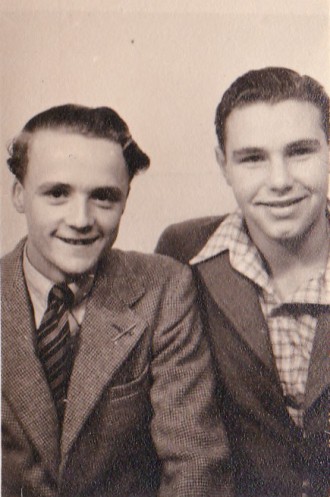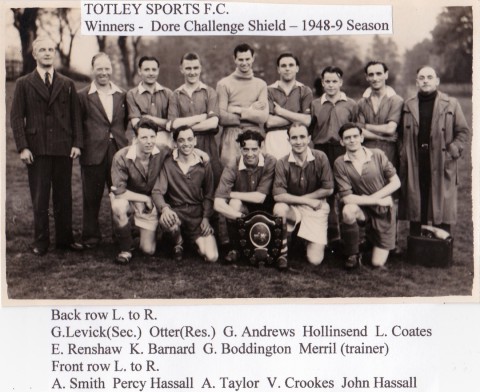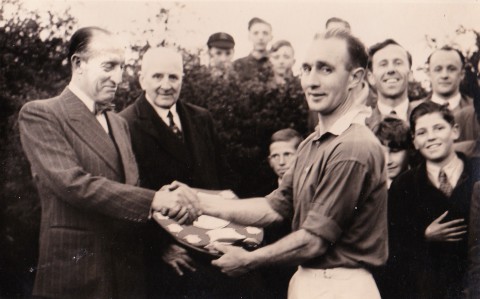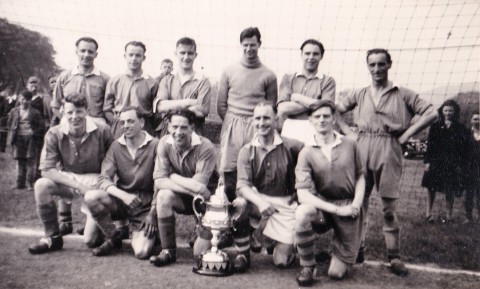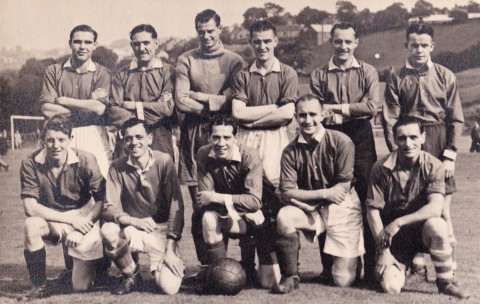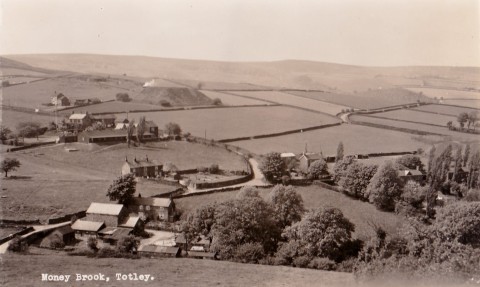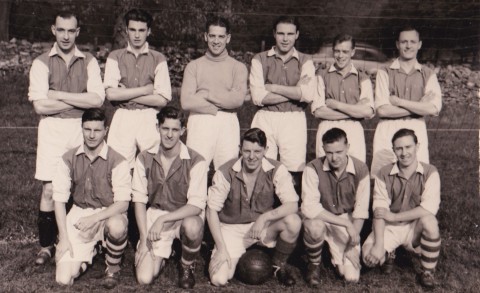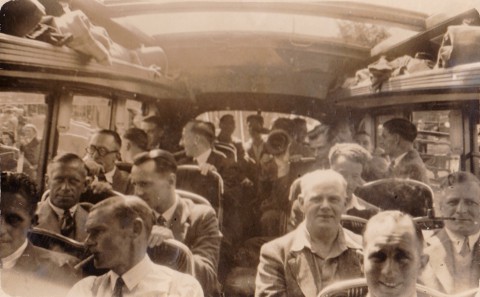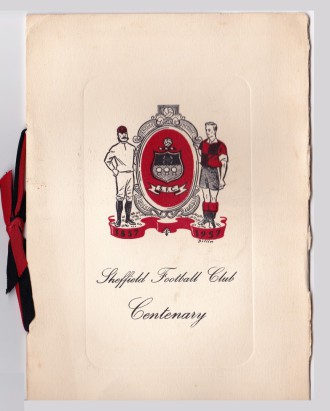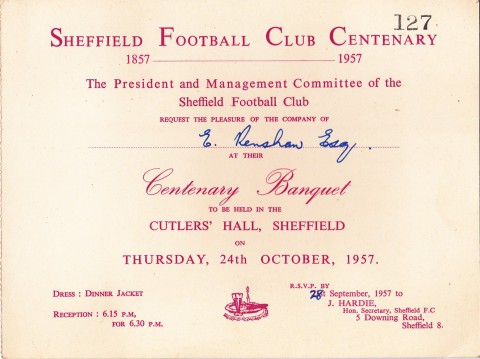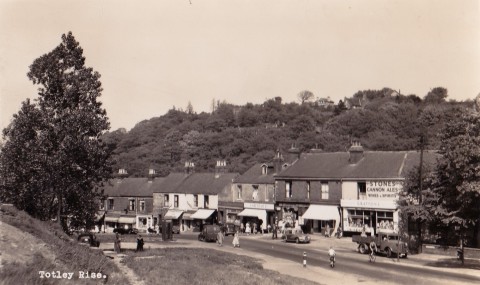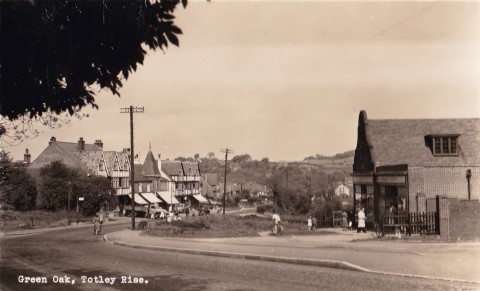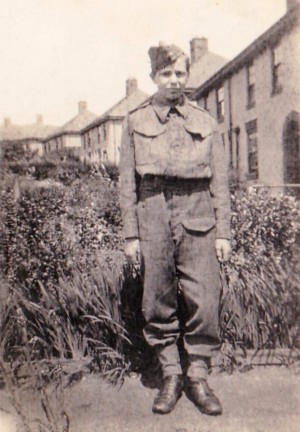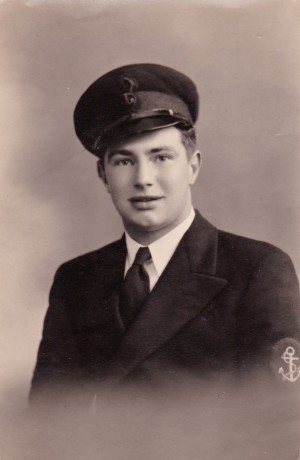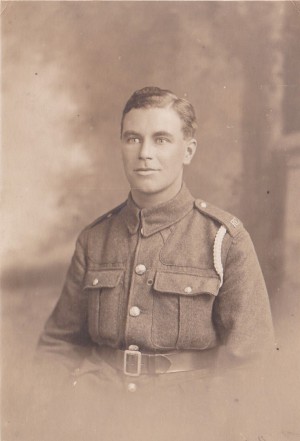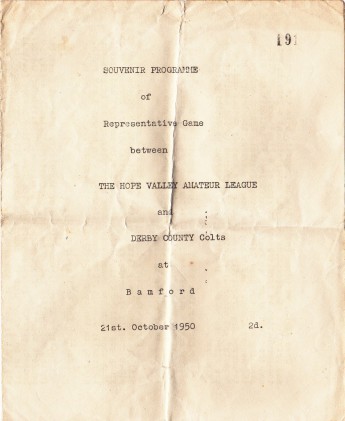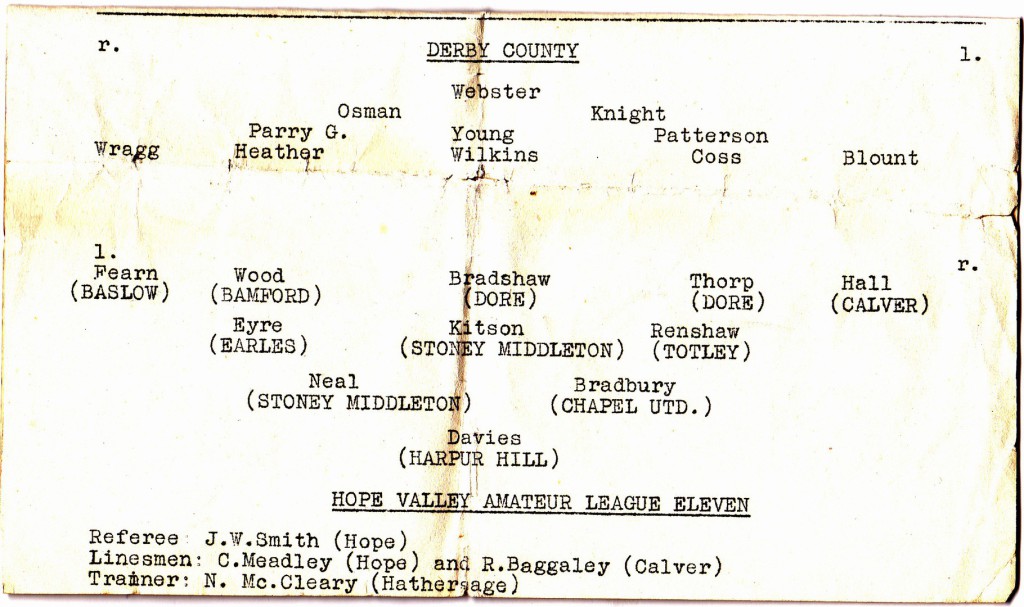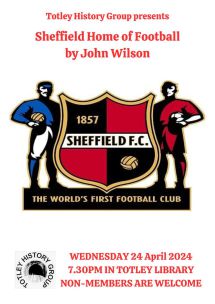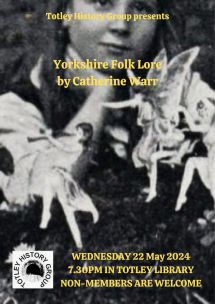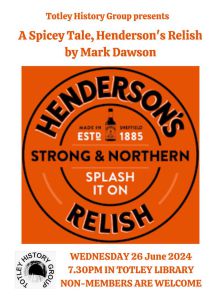A Farrago of Totley Sporting and Other Memories
by Eric Renshaw
Totley days were magical days for me particularly as a young boy and then again perhaps even more so in my late teens. I will explain as my modest contribution to Totley memories unfolds. My life in Totley started in 1932 in Aldam Road at the age of two and I left Totley in 1960 from Aldam Road still, at the age of 29. I think offspring remained a burden on their parents generally longer in those days than today.
I have lived away from the Sheffield area for some 42 years now, have made visits back from time to time but not to the Totley area for a long time. I may make a visit back in the near future and to Totley specifically and spend some time reminiscing and taking in what has changed and what has not changed. What has particularly focused my mind back to my early Totley days is discovering the Totley History Group web site by chance and The Totley Independent Paper and reading the interesting memories of Totley people I knew such as the late Archie Thomas, Bob Carr and others.
The magical days I have referred to in my late teens revolved around Totley Sports Football Club Team who I played for in the late 1940s early 1950s competing in the Hope Valley League. Our home ground was Totley Bents and it may well be that Totley Sports FC still play in the Hope Valley League with home games at Totley Bents. I was so enthusiastic and wrapped up with playing for the Totley team, particularly as I was the youngest player in the team and considered it such an honour to be selected and play for them. Saturday afternoons could not come round quick enough for me. There was great interest at that time in the team from Totley supporters and there were very good attendances at matches. Probably the fact there were not so many other distractions in those days as today was a factor. At Totley Bents ground for home matches it was not unusual when we had ‘needle’ games with top teams of the time such as Tideswell and our ‘derby’ fixture with Dore, for both sides of the ground to have spectators six deep. On away matches we sometimes had 2/3 coaches going into Derbyshire for key cup or league matches.
The late Archie Thomas held many positions in various organisations at one time or another which I believe included the President of Totley Sports Club during my time with them. I have read his memories on the Totley History Group site with great interest, and as an aside, one fact amongst many mentioned was that Aldam Road where I lived was named after Mr William Aldam Milner of Totley Hall and that I was never aware of until now.
Trawling through the many photographs on the web site and included under the section of ‘Old Totleyites’ I came across a photograph of a past Totley football team which I recognised immediately because I am on the photograph as a member of the team and I have a copy of this photograph. The caption on the photograph is ‘Totley Green Oak Football Club – Date Unknown’ However it is in fact a photograph of the club I have already referred to i.e. Totley Sports Football Club Team 1948/49 season who played in the Hope Valley League. I reproduce a copy of this photograph annotated accordingly and with the names of the players also.
This above photograph was in fact taken immediately after the conclusion of the final of the Dore Challenge Shield and it is rather clear that we were the winners. The match was played in May 1949 but at this point my memory for once fails me as to who our opponents were. Below is a photograph of the presentation of the Shield to our Team Captain Victor Crookes by I think the President or Chairman of the Hope Valley League.
1948-9 was a good season for the team as we also won the ‘Hope Valley League Challenge Cup’ known as the ‘Lawrence Cup’ so named presumably after the name of the person that gave the cup initially. I can remember many details of this final which was played at Baslow a neutral ground, again in May 1949 against Tideswell who at that time were the strongest team in the league and almost unbeatable.
Tideswell had many players who came from far and wide. Totley team was made up of players almost exclusively who lived in Totley with just a couple who came from not all that far away. Our chances of winning were not considered good ( except by ourselves) even though we also had a very good team. I can remember phases of that match with a degree of clarity as though it took place only last week even though it was some 66 years ago now. Tideswell were on top for much of the match and we had to put in some prolonged and stout defence to keep them at bay. With just minutes of the match remaining we were losing 2-1 and it looked like we were going to be gallant losers but a smartly headed goal from a corner kick levelled the scores at 2-2. With time fast running out we made a last gasp effort – a lovely defence splitting through ball was seized upon by our tricky winger John Hassall (the John Hassall who in later years became chairman of the board at Sheffield United Football Club – his brother Percy was the House Builder). Did I put that through ball out to John – perhaps so but perhaps not. John danced his way past two Tideswell defenders cut in at an acute angle and fired the ball low and hard with his characteristic right foot swerve into the far corner of the net. Only time for the restart – final referees whistle – match won 3-2 –euphoria for Totley players and supporters alike. It shows in the photograph of the team with the cup below, the players are looking pleased but exhausted. I don’t think the Tideswell team had their photograph taken! That night the win was duly celebrated in the Fleur De Lys hostelry in Totley Village centre.
Below is a further photograph of the team at that time and I include this because it is the best quality photograph taken by photographers ‘Carwood & Tayler’. An additional reason for including it is because in this photograph is Johny May a very good defender and also a frequent scorer of headed goals from corners at the other end. Johny did not play in the two finals perhaps because of injury. On the photograph below he is standing on the back row second left between yours truly and Len Coates the goalkeeper. This photograph was taken at Totley Bents and in the background is visible Chapel Fields with the Chapel behind and a glimpse of the path leading down to Totley Bents.
Sunday mornings were endurance training mornings for some of us hardy ones perhaps to take the stiffness out of our legs after Saturday matches. Generally the small group consisted of myself, John and Percy Hassall and sometimes others. Long walks were the order of the day at a fast pace covering many miles –we were keen to keep fit and the walks were very enjoyable too walking in the lovely Derbyshire countryside. These walks would range over Totley Moss, Blackamoor, around the Longshaw Estate and further perhaps to Toads Mouth overlooking the Hope Valley. On the return back home we might keep ourselves moving briskly by whistling marching tunes and even imitating various brass band musical instruments. Colonel Bogey was a favourite. On the occasions we passed other walkers during these improvised on the move musical performances then we received a few odd looks.
The photograph below looking towards Totley Moss shows the area of the start of a typical walk. Smoke can be seen emerging from an Air Shaft which is perched on the top of a rubble pile extracted during the construction, as a train passes through Totley Tunnel. As an aside I remember when I was younger when we were off on a day trip, perhaps to Blackpool having caught the train at Dore & Totley station, my Father who was an LMS Railway man would always pull his pocket watch on a chain out of his waistcoat pocket as we entered the tunnel, to time how long it took to go through the tunnel. Knowing the length of the tunnel the average speed of the train could be calculated and comparisons made with previous journeys. This information was not vital to anything at all but helped to pass the time.
The photograph below is of the 1950-51 Totley team and is notable in that only four of the 1948-9 team remain. Age in some cases had taken its toll. Anyone interested in such things will note that Alec Taylor, one of the remaining four has now switched positions from Centre Forward to Goalkeeper. He was good in both positions – what a versatile fellow.
Below is a photograph taken on the coach outside the Cross Scythes Hotel of players and supporters ready for the ‘off’ for an away match 1948-9 season. Sitting right front is Victor Crookes our Team Captain.
On the History website under ‘Family Searches’ is an article by Stewart Taylor researching his family history. Reference is made to his father Eric (Joe) Taylor and there is a photograph of the Dore football team circa 1947. Joe is on the photograph as one of the team and I can remember Joe when we (Totley) played our ‘derby’ games in the Hope Valley League against Dore. Those matches were always particularly keenly contested – robust but fair. I remember Joe as a very strong player – a very good player for Dore to have in the team and difficult to shake off the ball. He was a good few years older than me. Also in that Dore team I recognise particularly the player in the middle front row. His name was Thorpe (can’t remember his first name) – he was Dore’s centre forward in that era and a man to be feared by opposing defences. I am wondering if a Mr. Taylor who lived on Aldam Road the same road as myself at the time (known generally as ‘Sni Taylor’) was part of the same Taylor family. He was a very good cricketer (batsman) many years older than me. I played in Totley Sports Club cricket team with him at Totley Bents and one match particularly comes to mind where we made a strong partnership together at the crease. He was the dominant scorer – I mainly held one end up while he piled on the runs and if my memory serves me correctly he went on to make a ‘ton’ that day. Happy times.
In 1952 I was called into the Forces for two years National Service at the age of 21 (deferred from the age of 18 to complete studies). At the time I was hoping the authorities would forget all about me but they did not and in fact generally it turned out that those two years were very worthwhile in many ways. I came out of the Forces in 1954 having completed my two years but did not play for Totley again – the link had been broken. However I went on later to have a few seasons with Sheffield Club FC officially acknowledged as the oldest Football Club in the World. It is relevant to Totley history perhaps because at that time and for many years before and after, Sheffield Club FC had their ground at Abbeydale Park which of course is off Abbeydale Road just beyond Dore & Totley Station heading up towards Totley Rise. I was fortunate to be a player with Sheffield Club FC during that period because 1957 was the centenary year of the formation of the club. A number of events took place to celebrate this significant year for the club culminating in a Centenary Banquet at the Cutlers Hall Sheffield on 24th October 1957. The Guest of Honour was H.R.H. the Duke Of Edinburgh who was President of the Football Association.
As one of the players for the Club I received an invitation to the Banquet. Dinner Jacket was mandatory so out I had to go and buy an Evening Suit because I certainly did not have one. As a rather amusing anecdote to that, then I still have that suit, have worn it on many occasions, the last time about a year ago. As a concession to the passing years the waistband has been increased by two inches. The jacket is double breasted and it has been in and out of fashion over the years as fashions have changed. The material is so good it will never wear out.
Moving on to general memories I think the photograph below of Totley Rise is already shown on the website but I include it because the person standing behind the car parked in front of the Post Office, run at that time by Mr & Mrs Jackson, is in fact Mr Jackson. I would guess this photograph was taken late 1940s/early 1950s. The first shop on this photograph with Back Lane running down by the side of it behind the tree, is Grattons the grocers. Previous to Grattons it was a ‘Beer Off’ or to give the ‘posher’ title an ‘Off Licence’ called Taylors run by Mr. Taylor. I can recall customers from around Totley Rise district going into the premises carrying their own jugs to have them filled with foaming Tennants Ale or similar from ‘beer pumps in the shop, to be taken out and savoured at home.
The photograph below of the Cooperative stores on Baslow road at Green Oak taken around the same era has a gentleman in a white coat walking towards the Store. He is Mr Barker the Manager of the Butchers Dept. a well known person of the time and he has one or two mentions on the site.
Reverting back to Abbeydale Park then once a year, possibly I think in the late 1930s were held the ‘Abbeydale Park Galas’.They were amazing events with entertainments of all types going on covering the whole area of the site. Circus type shows, wild west shows and many others. I remember one booth called ‘knock the lady out of bed’. The idea was to throw a wooden ball at a small bulls eye target and if the tiny centre of the target was hit with sufficient force then a rather scantily attired young lady reclining on a bed would be tipped out into a pool of water to the delight of the thrower and onlookers. If you wished to come out of the grounds and return again the same day without paying a further entrance fee, your wrist was stamped with an indelible ink mark. Nothing quite on that scale goes on today. I think the shows were discontinued because the grounds were being churned up too much particularly the cricket pitch outfield area.(or perhaps it was the outbreak of war that put paid to them)
During the latter part of the 1939-45 war years I was a member of the local ‘Army Cadet Corps’ and from time to time we took over from the ‘Home Guard’ at Abbeydale Park to guard the stores including the ammunition stores. The local Home Guard had their HQ there. This guard duty involved guarding the Stores through the night as well and I remember the cry ‘call out the guard’ ringing through the depot two or three times during a night as nervous young guard cadets in their imagination thought they had heard and spotted interlopers in the dark which invariably turned out to be bushes and trees rustling or night wildlife on the prowl. We did have our senior officers with us to keep an eye on things. The Commanding Officer of the Abbeydale Home Guard was Colonel Hargreaves a local dignitary who I think resided in a large house/hall between Totley and Dore.
Some of the Cadets who were cricketers were allowed to practice in the nets of ‘Sheffield Collegiate’ who played at the Abbeydale Park cricket ground. On one occasion Collegiate had an evening match but due to some transport delay they were two players short and myself and a friend were invited to make up the eleven which of course we snatched at the chance. My one and only game with Collegiate was not exactly covered in glory. I was not required to bat because those above me lasted out the requisite number of overs. When it came to fielding I was placed towards the boundary edge out of harms way. The one occasion the ball came my way-yes I ran and retrieved the ball and stopped it going over the boundary rope for four but by the time I managed to get it back to the wicketkeeper the batsmen actually ran five. So it would have been better to have let it go over the boundary – ok so I was only fourteen!
As I sit typing and thinking then various additional memories of a varied nature cross my mind relating to my past Totley days, which I will now describe in no particular order but rather at random as I think of them, which will no doubt be extremely boring should anyone actually be reading this. At the beginning I mentioned magical Totley days as a young boy. I think many would agree that the part of life where one is young-school days can be carefree and seemingly just seem to go on and on, before the true realities of life set in with all the worries and cares that adult life may and most likely will bring.
I certainly, looking back found it that way and what better place could it be than Totley nestling in the foothills of lovely Derbyshire. At the same time you were only a twenty five minutes No. 45 bus ride away from the bustling steel/engineering dominated (as it was) city of Sheffield – sometimes referred to at the time as ‘a smokey picture in a beautiful frame’ with of course Totley being part of the frame. Included in the frame let us include Gillfield Woods which to we young boys (and the very occasional girl) was a marvellous adventure challenge. We referred to the woods as ‘little gilly’ and ‘big gilly’. From our perspective, little gilly started just beyond the Aldam/Greenoak area with Totley Brook running through the woods. There was then a gap in the wooded area and after that the rather mysterious but beckoning and alluring big gilly commenced. Quite a chunk of our leisure time was spent outdoors in this area come rain, hail or shine – not for us indoor pursuits.
We did I think respect the countryside around us but we indulged frequently in the sport of leaping across ever increasing widths of the river with often a considerable breathtaking vertical drop from one bank to the other. Wet shoes and clothes was frequently the outcome as our enthusiasm exceeded even our leaping ability, plus minor and not so minor injuries also and inevitably a scolding to look forward to on return home. The mysteries of big gilly were of course included and explored but I can’t remember if at that time we ever actually ventured completely to the far end. In the river there were lots of water wildlife including fish such as handsome speckled trout, whiskered bullshead, minnows and sticklebacks plus water voles. Is there still trout in Totley Brook I wonder?
The Shepley family occasionally had charity open days during the war years at their home Woodthorpe Hall located above little Gillfield woods and below ‘Wings Hill’ at the end of the ‘white drive’. I remember on one occasion listening in awe as a young adult member of the family gave a violin recital in one of the inner sanctums. And on a different note I also remember tearing down the white drive on my bike, brakes failing as the white drive met Mickley Lane on a bend just above where I think the Shepley Spitfire is now, and finishing up under the wheels of a car coming (luckily) fairly slowly down Mickey Lane. The driver was shaken poor chap and so was I but miraculously only minor injuries to me but the bike was never the same again. I apologised to the driver who took me home. I had many other hairy incidents but got away with them with only minor injuries – too numerous to go into here.
Like others I have memories of the C. of E. school at the Top of Totley and Miss Marsden the rather stern but kindly in her way, grey haired infants teacher. However the memory that stands out in my mind is not of a scholastic nature, but an occasion when Miss Marsden the grey smock that she wore flowing behind her, chasing a mouse around the school armed with a coke shovel from the fire, with all the children following in her wake. Much better than doing sums. Can’t remember if the mouse was ever caught – I hope not. There was a garden vegetable plot at the back of the school which we tended.
Sunday School classes were also held in that school building and I remember on one occasion after the session my older brother, Len Renshaw, and I being bullied by ‘Top of Totley’lads. (there was always a little bit of shall we say ‘rivalry or needle’ between the youth of ‘those from the top’ and we ‘Greenoak lot’). Anyway on this occasion I had to admire my brother later on when I was old enough to do so. At the time I was about five and he was thirteen and he was a rather timid boy but he stood up to them, protected me, and saw them off. Len is now 93 and is in a Care Home near me.
I had easy access to Greenoak Park as it was right at the back of our house on Aldam Road and I could just hop over the garden fence. If we were not in our spare time taking in the delights of Gillfield wood, we would likely be playing football or cricket in Greenoak park. Impromptu games of football or more organised games under the banner of ‘Greenoak’ against teams from other areas. Tommy Sampy who lived on Totley Brook Road and played for Sheffield United from 1920 until 1934 and used to do a little part time scouting for likely talent after his playing days were over, watched our matches at times to see if he could spot any likely potential. I am not sure any of us were that good. Greenoak Park had a slope to the ground and the main football pitch was on the upper part. There was also a pitch on the lower part and the Wesleyan’s from the Wesleyan Methodist Church used to play there. However the ground on that lower part was invariably wet and saturated and the pitch used to get churned up into a sea of mud. There was no ‘carpet’ style football played on that pitch!
When the snow and ice came in the winter months then winter sports took over. We would sledge on various slopes in the Totley area including the quite steep ‘Wings Hill’ mentioned by Bob Carr. Also there was outdoor ice skating on Tysack's Dam by Beauchief Gardens. Sometimes we would trek over Totley Moss and skate on the stretch of water at Longshaw. I remember on one occasion we skated until it was dark and then continued with car headlights lighting up the scene. Frozen ponds seem to last for weeks in those days.
I have noted that mention is made on the website of the family ‘Anderson’ style air raid shelters that were supplied to households during the 2nd World War for self erection. In the article, mention is made of a shelter on Mickley Lane that could not be used because it was continually full of water. We suffered exactly that same problem too and during air raid warnings we joined our next door neighbours in their shelter who did not have the water problem. Our neighbours on the other side also had a dry shelter but it was also put to a further use apart from sheltering during air raids. The man of the house played a trumpet in a band but his wife and family would not tolerate him practicing in the house, so he used to be driven out and he went and sat in the air raid shelter and practiced there, often quite late at night. We thus all around got the benefit of his playing and a trumpet is quite loud particularly when amplified in a corrugated metal sheeting air raid shelter.
I remember the first time we saw German bomber Aircraft passing over – it was a chilling sight and sound. Late one December 1940 evening (it was still light) we heard this incredible droning sound from above and looking up the whole sky was covered with formations of Aircraft very high up. It was clear they were German Aircraft, no doubt Dornier, Junkers and Heinkel bombers, not least because of the distinctive ‘wavy droning sound’ made by these German Aircraft. Some City was going to be in for an horrendous time that night- it was not Sheffield’s turn that time-perhaps Coventry. However it was Sheffield's turn on Thursday 12th December 1940 when the City centre was devastated.
Rather incredibly my Father, Fred Renshaw, walked home to Totley through the City that night while the nightmare was going on. He had been working late that evening and had just set off to go home from the LMS Railway Booking Office where he worked, when it all started. I know he continued walking but took shelter in an Air raid shelter in the City centre when the bombing intensified. However for some reason he took it into his head to leave the shelter and carry on his way even though the bombing was still going on. It turned out in fact that it was provident he did leave that shelter because after he left it was hit with a resultant number of casualties. So he just carried on walking-down the ‘Moor’ which was ablaze from top to bottom and on to Totley and home.
My Mother and I had been sheltering with the next door people in the Anderson shelter and when the ‘All Clear’ sounded we went back into our house and there was my Father sitting calmly in the living room. To cap it all if possible, my elder brother Len had also been working late that night in offices going towards the East End, and he spent the night sheltering under the ‘Wicker Arches’. He did not arrive home until next day.
Trades people doing their rounds included the ‘Rag & Bone man’ with his horse drawn dray (shades of Steptoe) making his presence in the area known with his raucous cries. For a bundle of old clothing the reward would be a ‘pumice stone’ that ladies of the household would use to whiten the edges of steps leading up to the house. The white coated Ice Cream salesman would appear on his tricycle with an iced packed box on the front calling out ‘stop me and buy one’. The favourite would be a triangular fruit flavoured iced treat with a cardboard covering. One old penny for a full one or half penny for a half one. The horse drawn vehicles of that time provided a bonus over motor vehicles. The horses were prone to leave their visiting cards on the roads and as if by magic within seconds people would emerge from the houses armed with buckets and shovels to compete for this valuable commodity. This would be used to fertilise vegetable plots in back gardens and allotments to help the ‘Dig for Victory’ campaign. We had an allotment just the other side of Greenoak Park mainly tended by my Father but when the Pre-fab houses were constructed a new area for allotments was allocated between the white drive and Mickley Lane up towards St, Georges Farm. This was not so convenient but my Father still had one.
At the age of 11 I started at Greystones school in Sheffield and after a while I got a little part time job with Hobsons Chemists of Millhouses. They had a sub branch in the Totley Rise row of shops and one of my jobs was to deliver supplies by means of a delivery bike with front basket, from the main Millhouses shop to the Totley Rise shop on my way home from school. Next morning I would ride the bike back to Millhouses with anything to go back from the Totley shop, and then carry on to school. The bike was extremely front end heavy and difficult to control. On one occasion I very nearly came to grief. Riding back down to Millhouses the wheels of the bike became trapped in one of the tramlines near the old Millhouses terminus while travelling at speed. The bike was so heavy I could not dislodge it and I just had to carry on way past the shop when somehow I was able to stop and gain control. Another job I had at a different time was delivering papers for the much mentioned Mr & Mrs Wesleys shop at Greenoak, covering the Heatherfield Estate. I remember Mr & Mrs Wesley as a very nice well respected couple and I can picture them both in my minds eye.
The National Health Service commenced in 1948. Before that time there was a National Insurance Scheme for Workers who paid a small weekly amount which covered their families also, put in place in
1911 by David Lloyd George. Medical issues in the Totley Greenoak/Totley Rise areas were covered in my Totley days by Doctors Murphy and Roper. The surgery was in the front parlour
of Mr. & Mrs Coates house on Baslow Road just up from Totley Rise. I can only remember attending surgeries in the evening – you just turned up and waited your turn – no appointment system but at
least you were seen that day.
Mr. Coates by the way was one of the local ‘Coal Merchants’ and he had a competitor – Mr. March who lived on Aldam Road. They were both fairly small in stature but strong which was necessary to be carrying large heavy bags of coal day in day out.
I left Totley with regret on my marriage in 1960 at All Saints Church Totley (the Vicar was the Rev. Frederick Adamson). It is a coincidence that my wife Joyce was born in Totley Rise and lived on Abbeydale Park Rise until the age of five when her parents moved to Millhouses. We did not meet until I joined Brincliffe Lawn Tennis Club, Sheffield Circa 1955 – or did we meet before that ? both our Mothers would do some shopping I would think at the Totley Rise shops.
To close on, then as can be seen I have very many happy memories of living and growing up in Totley as others have also. Many from Totley (and Dore) have gone on to have notable achievements one way or another large or small. Myself? Well I did come in third in the 5/6 year old boys 40 yards flat race in Greenoak Park as part of the festivities for the Coronation of King George VI, as I discovered when trawling through the Totley History Group website.
Eric Renshaw
South Staffordshire
July 2015
Update
Eric subsequently came across a Souvenir Programme from a football match in which he played for a Hope Valley Amateur League Eleven against Derby County Colts. The match was played at Bamford on 21 October 1950. Two Dore players also played for Hope Valley, Bob Bradshaw and "Thorp" (Dore had four Thorpes in their team around this time, Alex, Billy, George and Graham).
Search Our Website Here
Future Meetings
April
May
June
Unless stated otherwise our meetings are held in Totley Library on the 4th Wednesday of each month at 7.30pm.
Pauline Burnett's book The Rise of Totley Rise has been revised and updated. It tells the story of this small piece of land from 1875 when there was only a rolling mill and chemical yard alongside the river a mile from Totley, through Victorian and Edwardian times, two world wars and up to the present day. It has 94 pages including a useful index and many illustrations from private collections. The book is available now from Totley Rise Post Office priced at £5, or through our website when an additional charge will be made to cover packing and postage.
A few copies are still available of Sally Goldsmith's book Thirteen Acres: John Ruskin and the Totley Communists. Totley was the site of a utopian scheme funded by art critic and social reformer John Ruskin. In 1877 he bought 13-acre St. George’s Farm so that nine Sheffield working men and their families could work the land and, to keep themselves busy, make boots and shoes. Sally tells an engaging story from our history with a quirky cast of characters including Ruskin himself, the poet and gay rights activist Edward Carpenter and Henry Swan, a cycling, vegetarian artist and Quaker. The book is available to order online from the The Guild of St. George by following this link.
A recently discovered box of WWII correspondence reveals the story of how a small group of ladies from Dore and Totley recruited knitters from the west of Sheffield and how their efforts made them the country's greatest provider of Comforts for the Minesweeping crews of the Royal Navy. The story is told in Knit For Victory, a new book from Totley History Group. Written by Pauline Burnett, it has 82 pages and many illustrations. It is on sale in local shops and via our website. Further information about the correspondence is in this inside page of our website: Dore & Totley Minesweeping Trawlers Comforts Fund.
The story is told in Totley War Memorial WW1 of the ten men from our village who gave their lives in the Great War. Written by Pauline Burnett, Jim Martin and Dorothy Prosser, a chapter is devoted to each of the soldiers with a family tree followed by as much information as could be discovered about the men and their families. There is also information about their military careers and the actions in which they lost their lives. The book has 64 pages and is illustrated throughout with photographs of the men, their families and the houses where they lived.
Totley All Saints' Church Parish Magazines for the years 1985-2006 with notices of baptisms, marriages and funerals and accounts of spiritual, educational, charitable and social matters in the village. Scanned in full, including advertisements from local traders.
In 1893 during the building of the Totley Tunnel there was an outbreak of smallpox amongst the navvies which spread to some of the local population. 17 people were buried in communal graves in Dore Churchyard, 6 from "Green Oak" (Lemont Road). The severity of the outbreak was principally caused by overcrowding and insanitary conditions in lodging houses .
Kathleen Grayson was a 39 year old housewife when WW2 broke out. She volunteered for the ARP and became an ambulance driver. During an air raid on Sheffield in July 1941, and despite her own injuries, she managed to get a seriously injured casualty to hospital. For this she was awarded a commendation from King George VI. Together with her friend Hilda Duffy, Kathleen also assembled a team of knitters to provide essential warm clothing for the men serving on the minesweepers patrolling the North Sea.
We have recently bought at auction the WW2 memorabilia of Douglas Platts whose family home was at Hillside, 98 Queen Victoria Road. After the war Douglas returned to his civilian occupation working in the family scissors manufacturing business. He lived in our area for the rest of his life.
We are very grateful to Mrs Valerie Taylor of Dore for lending us the title deeds to Lower Bents Farmhouse which is reputed to be the oldest surviving building in the area with a proven history back to 1621. We have now scanned and transcribed the deeds which could be particularly interesting to anyone with a connection to the local Fisher, Dalton and Marshall Families.
Until 1844, when Dore Christ Church parish was created, Totley township was part of Dronfield parish. We have now transcribed the burial records for former Totley residents at St. John the Baptist, Dronfield for the period 1678-1870 and at St. Swithin, Holmesfield for the period 1766-1901.
Whilst researching the history of the Dalton Family we found it useful to transcribe a number of early Wills and Inventories. These and those of many other Totley, Dore and Holmesfield people dating from between 1594 and 1856 have now been added to our website.
St. Swithin's Church, Holmesfield pre-dates Dore Christ Church and was the place where many of the people from Totley worshipped and were baptised, married and buried. Read the inscriptions on more than 750 gravestones in the churchyard including those of Mr. and Mrs. William Aldam Milner of Totley Hall, Jessie Matilda Tyzack (nee Fisher) of Avenue Farm, and Rev. J. A. Kerfoot of St. John's, Abbeydale.
Thomas Youdan was a music hall proprietor and benefactor who was living at Grove House, Totley in 1867 when he sponsored the first football knockout competition in the world for The Youdan Cup.
The words Millhouses Cricket Club can be seen in the background of team photos which are likely to date from between 1905 and the early 1920s, very probably pre-war. They were lent to us by Garth Inman who can identify his great uncle, Cecil Inman, in some of the photos and would like to know when they were taken and, if possible, the names of others present. Please take a look to see whether you can put names to any of the faces.
Josiah Hibberd was seriously injured whilst working on the construction of the Totley Tunnel in 1892. He died on 9 May 1897 at the age of 38 having apparently spent most of previous five years in hospital.
Bradway House was built around 1832 by Henry Greaves, a farmer, together with two adjacent cottages. We have traced most of the occupants of the property from these early days up to the start of World War Two.
We have transcribed the baptisms records at St. John the Evangelist, Abbeydale from when the church was consecrated in 1876 until just after the start of World War 1. The records are arranged in alphabetical order based upon the child's name and show the date of baptism, the names of the parents, their home location and occupation.
Nick Kuhn bought an original 1920s poster which had this owners' blind stamp in one corner. The stamp almost certainly refers to a house named Wigmore that was built in the late 1920s or early 1930s. The first occupiers that we can trace are John Howarth Caine, a district mineral agent for the LNER, his wife Florence Jane (nee Prince) and daughter Doris Mary. The Caine family lived at Wigmore until 1936 by which time the house would have been known simply as 12 The Quandrant.
George Griffiths died on 13 December 1888 following an explosion during the sinking of number 3 airshaft at Totley Bents. His widow Florence died shortly afterwards and his two daughters Maud and Annie were adopted separately. Whilst Annie lived the rest of her life in Yorkshire, Maud emigrated to Australia in 1923 with her husband, John Burrows, daughter Margaret and son Jack, pictured above.
George Wainwright was said to have been born in Bamford, Derbyshire in 1714. He learned the trade of linen weaving and moved to Totley after his marriage on 1744. He became an ardent follower of John Wesley who paid many visits to Sheffield and who would have passed through or close to Totley. Preaching was at first conducted out of doors and when Wesley's preachers became harassed by a mob of Totley ruffians in 1760, George offered them safety of his own home. He remained a Methodist for all of his long life, dying in Dore in 1821 at the reputed age of 107.
Oakwood School was started by Mrs Phoebe Holroyd in 1925 initially as the Firth Park Kindergarten and, by 1927, as the Firth Park Preparatory School. Phoebe was still working at the school almost fifty years later when she was well into her seventies. We would like to hear from anyone with memories of the school.
James Curtis was born at sea aboard HMS Chichester in 1790. He enlisted as a Private in the 1st Grenadier Regiment of Foot Guards in Sheffield in 1812 and served in Spain and Portugal during the Peninsular War. He later fought in France and Belgium taking part in the Battle of Waterloo. In later life James lived at the Cricket Inn where his son-in-law William Anthony was the licensed victualler. He died in Heeley in 1882 aged about 91.
Charles Paul lived in Totley in later life. He was a local historian and archaeologist who was an authority on the history of Sheffield, especially the two areas he knew best: Attercliffe and Ecclesall. His books and letters to local newspapers were published under the Latin form of his name Carolus Paulus.
Towards the end of the 19th century Totley Hall gardens became a well known beauty spot that attracted many hundreds of visitors from Sheffield on open days and the rock gardens became one of its most popular features. Mrs Annie Charlesworth sent us six glass transparencies of the rock gardens taken, we believe, in the early years following the Great War.
Anton Rodgers send us photographs of three water-colours that had been bought by his grandfather at a sale of the contents of Abbeydale Hall in 1919. One was of a scene said to be in York by A. Wilson. A second was of a seated child with a dog believed to be pianted by Juliana Russell (1841-1898). The third was of Lake Como, by Ainslie Hodson Bean (1851-1918) who lived for much of his life on the Riviera and in North Italy.
A Canadian correspondent sent us photographs of a set of silver spoons that were bought in a small town in British Columbia. The case contained a note signed by Ebenezer Hall indicating that they were a wedding gift to Maurice and Fanny Housley. We think we may have traced how they got to Canada and where they might have been since.
Green Oak Park was opened on 23 March 1929 on land that had been bought by Norton District Council from John Thomas Carr, a farmer and smallholder of Mona Villas. In later years, the buildings were used by the Bowling Club (the green having been built in 1956) and by the park keeper. However, the buildings appear to have been constructed in several phases, the oldest of which predates the park to the time when the land was used for pasture.
We believe the old Totley Police Station at 331 Baslow Road was built around 1882. Two lock-up cells were excavated just below floor level in the summer of 1890. We have traced the Derbyshire Constabulary police officers who lived there from John Burford in 1886 to George Thomas Wood who was there when Totley was absorbed into Sheffield in 1934.
David Stanley lived in Totley Rise in the later years of his life. Born in Bulwell, Nottinghamshire, he joined the 17th Lancers when he was 19 and rode in the Charge of The Light Brigade at the Battle of Balaclava where he was seriously wounded. For the first reunion of veterans in 1875, he told his story to a reporter from the Buxton Herald.
This picture postcard was addressed to Miss Abell, Holly Dene, Totley Brook Road and posted in Rotherham on 10 December 1907. Edith Annie Abell was born on 4 February 1887 in Sheffield and her family came to live in our area in the 1900s, staying for the rest of their lives.
Charles Herbert Nunn enlisted in the British Army on 23 August 1915 and was sent to France on 18 December 1915 to served with the British Expeditionary Force. In March 1916 it was discovered that he was underage and he was returned home. Shortly after his 18th birthday he re-enlisted and was again posted abroad where, in addition to this trio of medals, he was awarded the Military Medal.
This certificate was awarded jointly by the Red Cross and St. John's Ambulance to Isaac Henry Williams, of Lemont Road, for his services during WW1 as a stretcher bearer. We are seeking anyone who can help us pass it on to a living relative.
In 1832 Samuel Dean pleaded guilty to stealing a quantity of lead from the Totley Rolling Mill and was sentenced to seven years transportation to Australia. He sailed on the Mangles and upon arrival in New South Wales he was sent to work for William Cox, the famous English explorer and pioneer. After receiving his Certificate of Freedom in 1840, Samuel became a farmer and went on to have a very large family. Samuel was born in Whitechapel around 1811 to parents Samuel Dean Snr. and Susannah Duck. His descendant Sarah Dean would like help in tracing his ancestry.
Ellen Topham was born in 1889 in Nottingham. Her parents had been living together since 1862 but had never married so it was most unusual that, after their deaths, Ellen was accepted into Cherrytree Orphanage. Even more so since her father, Snowden Topham, had been acquitted somewhat unexpectedly in a widely reported manslaughter trial. Ellen remained at Cherrytree until her death from pulmonary tuberculosis at the age of 15.
Mabel Wilkes was a resident in Cherrytree Orphanage between 1897 and 1905. Her granddaughter Sally Knights sent us these images of a book presented to Mabel as a prize for her writing. Sally also sent us some personal memories of her grandmother and a photograph of a locket which contains portraits of Mabel and her husband Septimus Gale.
John Henry Manby Keighley was living at Avenue Farm when he enlisted in 1916. He fought in France with the Cheshire Regiment but after home leave in early 1918 he went missing. The Army were unable to determine whether he had deserted or returned to the front and been either killed or captured by the enemy. In August 1919 he was formally presumed killed in action but it appears he did not die but returned home to his family.
Horace Ford was admitted to Cherrytree Orphanage on 26 October 1888 at the age of six. He left at the age of 14 to become an apprentice blacksmith and farrier. Soon after his 18th birthday Horace enlisted in the Imperial Yeomanry to serve his country in the war in South Africa. His letter home to his Orphanage mentor tells of the lucky escape he had in battle.
Pat Skidmore (née Sampy) lived on Totley Brook Road from 1932 to 1948 before her family moved to Main Avenue. In this short article she remembers her time at Totley All Saints School where she was a contemporary of Eric Renshaw and Bob Carr.
As we have nowhere to exhibit memorabilia and artifacts, we have created a Virtual Museum instead. The latest addition to our collection is this double-sided Totley Rise Post Office oval illuminated sign which was on the wall of 67 Baslow Road before the Post Office business transferred to number 71. Please contact us by email if you have things that you own and would like to see added to the virtual museum.
Conway Plumbe was a man of many talents who came to live in Totley Rise around 1912. As a young man he had poems published by Punch magazine and is remembered in modern collections of WW1 poetry. A number of his paintings were accepted by the Royal Academy. An engineering graduate of London University, he joined the Civil Service where he rose to a high level as a factory inspector, publishing two books on the subject and giving a series of talks on workplace health and safety on BBC radio during WW2. In retirement he wrote a philosophical-spiritual work called Release From Time.
Inside Totley Rise Methodist Church there is a Roll of Honour commemorating the soldiers from its congregation who served their king and country during the Great War. For all but one of the 28 names the soldier's regiment is recorded in the next column. The exception is David Cockshott for whom 'killed in action' is written alongside yet he appears on no war memorial in our area and no record of a mortally wounded soldier of that name is to be found. We think we have solved the mystery.
Mrs. Kate Plumbe moved from Mansfield to Totley Rise with a number of her family in 1913 and became closely involved with the Totley Union Church. Her daughter Winifred became a missionary and headmistress in Calcutta for over 38 years following which she returned home to live with her sister Hilda on Furniss Avenue. Hilda had also been a teacher, missionary and, like her mother, a volunteer at St. John's VAD during WW1.
Thomas Glossop was a cutler and razor manufacturer who was well known amongst cricketing and gardening circles. Despite going blind, he was able to continue his hobbies with remarkable success
The Totley Union Cycling Society Prize Giving and Fete was held on the fields near Abbeydale Hall on 18 July 1914. Anne Rafferty and Gordon Wainwright have named some of the people in two wonderful photographs of the event. Can you identify any more for us?
The Tyzack family are well known in our area for owning iron and steel trades at Walk Mill, Abbeydale Works, Totley Rolling Mill and Totley Forge. This article covers the history of the family from the late 18th century when William Tyzack the founder of the company was born until the early 20th century when Joshua Tyzack farmed at Avenue Farm, Dore.
Walter Waller Marrison moved to Totley around 1897 with his wife and their two young sons. He was a house builder who constructed properties around Totley Brook and Greenoak before ill health forced him to take up less physically demanding work. In 1904 he took over the tenancy of the grocers and off licence at number 71 Baslow Road. After his death in 1908, his widow Kate and later their eldest son Jack continued to run the business until it was sold in 1934.
Ron Wijk of Nieuw-Vennep in the Netherlands has sent us two scanned images of drawings of old cottages made by the celebrated Dutch painter, Anton Pieck (1895-1987) simply annotated "Totley", and wondered whether we could identify their locations.
We would like to thank Christopher Rodgers for bringing to our attention this fascinating log of the 85th Sheffield (St. John's and Totley Orphanage) Wolf Cub Pack for 1927-45. The log is published jointly by Sheffield Scout Archives and Totley History Group as a free PDF download. It is illustrated by no fewer than 92 photographs and is supported by a comprehensive index and biographies of some of the main participants.
Following our Open Meeting event on School Days, Roger Hart, Howard Adams and John Timperley have each written to us with their memories of Norwood School, which was located in the rooms attached to the Dore & Totley United Reformed Church on Totley Brook Road.
On 22nd July 1909 the children of Dore and Totley Schools celebrated by a pageant the union of England under King Ecgbert which took place at Dore in AD 827. The pageant was devised and written by Mrs Sarah Milner and her daughter Marjorie and performed in a field close to Avenue Farm in front of a large audience. Photographs of the event survive together with a fragment of the script.
John Edward Greenwood Pinder had lived all 46 years of his life in Totley but on census night, Sunday 2 April 1911, he was not at home; he was in Derby Gaol serving a sentence of three months hard labour. From the age of 20, John had been in and out of local courts for a series of minor offences including drunkenness, assault, wilful damage and night poaching. Finally he was sent to gaol for cutting down and stealing 86 small trees which he sold in Sheffield market for Christmas.
We have already transcribed the census returns for Totley, Totley Rise and Dore. Now we have transcribed Census Strays. These are people who were born in Totley but are missing from our earlier transcriptions. They may have been living, working or studying elsewhere or just away from home on the night the census was taken. Two people were in prison. Others were in Union Workhouses, hospitals and asylums. Fully indexed strays from the 1851, 1861, 1881, 1891, 1901 and 1911 censuses are available now.
We wish to thank Gillian Walker for allowing us to digitize an archive of material about the 1st Totley Scout Group. Most of the material was collected by Arthur Percival Birley in the period 1949-51 and there are many interesting documents pertaining to the building of the scout hut on Totley Hall Lane. In addition four Newsletters survive, two from the 1940s and two from 1971.
We are grateful to Angela Waite and All Saints' Parish Church for giving us access to baptismal and kindergarten birthday rolls dating from 1926 to 1941. We have transcribed the names, addresses, birthdates and baptismal dates and created an alphabetical index of entries for you to search.
Edmund Sanderson, a Sheffield estate agent, aquired the land on either side of the old drive to Totley Grove in 1874 and divided it into plots for development. He called it the Totley Brook Estate. But before many houses were built, the estate road was severed in two by the building of the Dore & Chinley Railway line. The eastern end of the road became the cul-de-sac we now call Grove Road.
John Roberts was born in Sheffield in 1798. He became a partner in one of the leading silversmiths firms in the city before moving to Abbeydale Park in 1851 and extending the house in Victorian gothic style. He paid for the building of St. John's Church and was believed to dispense more in charity than any other person in the neighbourhood including his protege Ebenezer Hall.
The Coke Family owned the Totley Hall Estate from 1791 to 1881. With the aid of a family tree to guide us, Josie Dunsmore takes us through the story of their tenure.
When the Rev. D'Ewes Coke inherited the Totley Hall Estate in 1791 it had two farms. Josie Dunsmore tells the story of how the two farms were combined under the tenancy of Peter Flint with the aid of field maps drawn by Flint himself and later by the Fairbanks family.
Do you think you recognize this face? More than sixty photographs of the girls and teachers at Hurlfield Grammar School for Girls in the 1940s were given to Totley History Group by Avril Critchley, who was herself a student at the school. The collection includes fifteen form photographs from June 1949. There would have been a number of girls from the Totley area attending the school in those days.
Christine Weaving tells the story of her 2 x great uncle George Edward Hukin, a Totley razor-grinder, and his life-long friendship with the academic, poet, writer, and free-thinker Edward Carpenter.
Eric Renshaw (pictured here on the right with Bob Carr) grew up and lived in Totley from 1932 to 1960. Many of his memories are of a sporting nature.
We are very grateful to Gordon Grayson for giving us this splendid sale document for the Norton Hall Estates, following the death in 1850 of Samuel Shore. The estates included a large part of Totley and the document has maps and illustrations, plus schedules of land and property with the names of tenants. We have also added a transcription of the entries for Totley and Dore.
Watch this Youtube video of the talk given by Dr. Mark Frost and Sally Goldsmith on Ruskin, Totley and St. George's Farm. The talk was hosted by Totley History Group on 20th May 2015 as part of the Ruskin in Sheffield programme. Also enjoy a video of the outdoor performance Boots, Fresh Air & Ginger Beer written by Sally.
When Jacqueline A. Gibbons became interested in what made her father tick, it began a journey through WW1 archive records and led to her flying from Toronto to visit the house and village where he lived and the countryside that he so much enjoyed. Jacqueline reminds us that in the early 20th century Sheffield was a driving force of industry and that Totley was the place where many of its remarkable people lived and where they formulated their ideas.
Edgar Wood was the designer of The Dingle, 172 Prospect Road, built in 1904 for Rev. William Blackshaw, the founder of the Croft House Settlement. The house, together with its western terrace and boundary walls, has now been awarded Grade II listed building status.
What was probably "the most perfect little garden railway in existence" in 1910 was to be found in the grounds of Brook House, Grove Road, the home of its designer and constructor, Guy Mitchell. Look at some wonderful photographs and read reports in newspapers and a full appreciation in Model Railways magazine.
We have now completed our transcription of Totley School's Admission Records for the period from 1877 to 1914. There is also a useful index to the names of the scholars and to their parents or guardians. We are very grateful to Sheffield Archives and Local Studies Library for allowing us to transcribe and publish these records and for permission to reproduce the photograph of a specimen page of the register.
On 8, 9 and 11 November 2014 Totley History Group held an exhibition at Dore & Totley United Reformed Church to commemorate the centenary of the First World War. Below are additional links to some of the photographs we were lent and stories we researched especially for the exhibition.
Oscar Creswick was a local farmer who served with the Army Service Corps in Salonika and who after the war returned to Totley to become the innkeeper of the Cricket Inn and a member of the village's successful tug of war team.
Walter Evans was a market gardener who also ran a small grocery shop on Hillfoot Road when war broke out. He fought with the Machine Gun Corps at the fourth battle of Ypres. After the war, Walter ran a grocers shop at the top of Main Avenue.
Fred Cartwright was another Totley soldier who survived the Great War. He fought in France and Belgium and although he wasn't wounded he was gassed and was home on sick leave when his daughter was delivered by Nurse Jessop during a snowstorm in January 1917.
Maurice Johnson joined the Yorkshire Dragoons, a territorial unit, on 1 Jan 1914 and so was called up at the very start of the war. He fought throughout the war on the Somme, at Ypres and at Cambrai. After demobilization in 1919 Maurice returned to his old occupation in the steel industry.
Bill Glossop lent us a letter written by his father, William Walton Glossop to his wife describing life in the army during training in the north east of England and asking her to keep him in mind with the children.
The photo above provides a link to an album of photographs taken of WW1 Hospitals at St. John's, Abbeydale and the Longshaw Estate.
Nora Green, of Chapel Lane, was only 14 when war broke out. In 1914 she was ill with diphtheria and was sent to the isolation hospital at Holmley Lane, Dronfield. Nora recovered and wrote a letter of thanks to one of the hospital staff and the reply she received survives.
We have collected together on this page the names of local men who appear on various War Memorials and Rolls of Honour in Totley, Dore, Abbeydale, Norton, Holmesfield and Dronfield.
Unfortunately we were unable to identify all the photographs we were lent of Totley Soldiers. Please take a look at this album to see if you recognize any of the missing names.
This walk visits locations that have strong associations with Totley during the First World War. It includes the homes of the ten soldiers from the village who lost their lives, the auxiliary hospitals, war memorials, and even the rifle range on which the soldiers trained. Take a look at the first draft of a new walk by the authors of "Totley War Memorial WW1 1914-1918"
We wish to thank the Trustees of Cherrytree for giving us permission to publish transcriptions of the Cherrytree Orphanage Admissions Book entries for the years 1866-1929. There is also an alphabetical index for you to look at.
With more people having access to faster broadband and mobile networks, we have uploaded seven full and unedited oral history recordings and also added more short excerpts for you to listen to.
Our transcriptions of local trade directories have been expanded to cover the 95 years from 1837-1932 and have also been indexed. From the days when there were a handful of farmers, stone masons, saw handle makers & scythe grinders to the wonders of the Totley Bridge Garage Company, Betty's Boudoir and The Heatherfield Shopping Centre.
We continue to add to our Totley Newspaper Archive. Recent entries have included several about The Plumbe Family, Thomas Glossop and accidents during the construction of Totley Tunnel.
Totley Church of England Parish Magazines for the years 1922-1939 and 1948-1967 with notices of births, marriages and deaths and accounts of spiritual, educational, charitable and social matters in the village.
Around 90 photographs taken by Stuart Greenhoff for his thesis A Geographical Study of Dore and Totley including several of Totley Moor Brickworks. Superb!
Chronologically ordered snippets of information recorded by Brian Edwards during his many years of research into our local history.
Read the inscriptions on more than 700 gravestones in the churchyard.
Visitors since 24 Sep 2012:


